Healthy Buildings
1. HEALTH & WELLBEING AT THE CENTRE OF DESIGN

Clayworks believes that the health and wellness of people and the planet should be at the centre of the design and construction of new and retrofit buildings.
More than half of the air we breathe in our lifetime is inhaled inside the home—another large percentage in the workplace.
Studies have shown that air pollution contributes to the large global burden of respiratory and allergic diseases, which include asthma, chronic obstructive pulmonary disease, pneumonia and possibly tuberculosis. There is an emerging body of evidence that air pollution can disrupt physical and cognitive development in children.
Indoor Air Pollution is estimated to be 2 – 5 times higher indoors than outdoors. A recent study released by the National Air Quality Testing Services described homes in the UK as ‘Toxic Boxes of Pollution’.
Researchers have also identified a clear relationship between indoor air quality and human productivity in buildings. On average, 10% of productivity loss could be attributable to health issues related to poor indoor air quality in office buildings.
Enhanced air quality positively correlates with improved health, cognitive and physical development, higher incomes and better economic performance.
2. SIMPLICITY
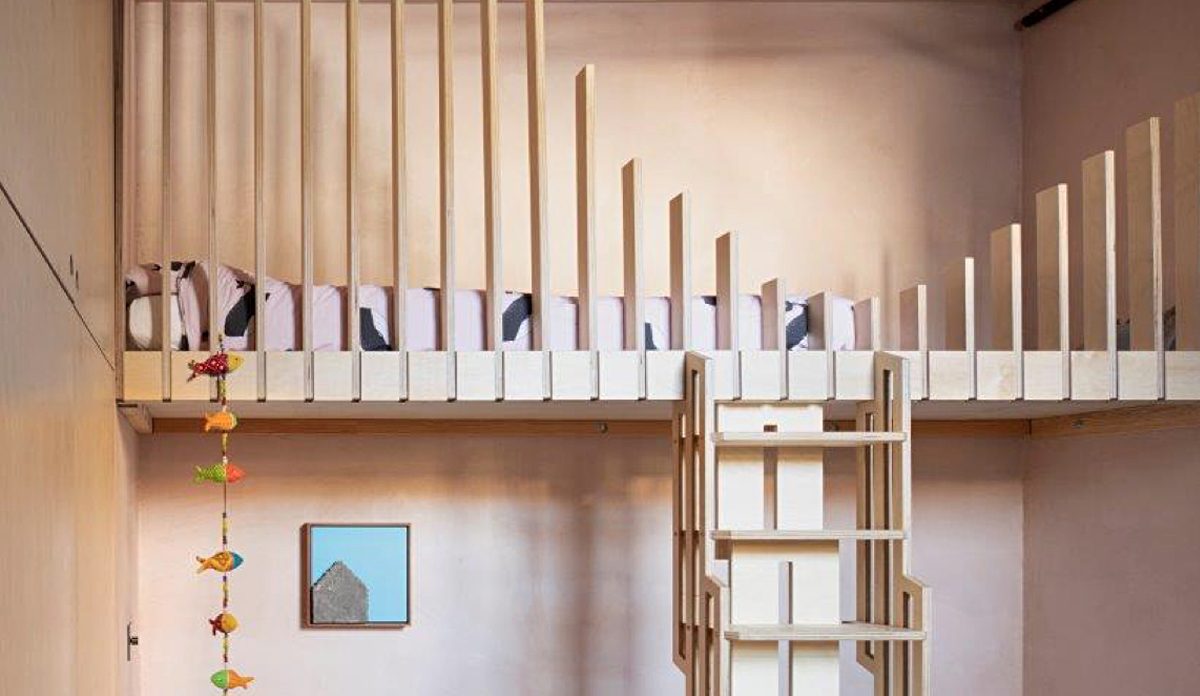
There is no need for smart technologies for a healthy interior environment
Imagine a material that is chemical & toxin-free, fully recyclable, naturally breathable, fire retardant, sound-absorbing, thermally efficient and has anti indoor air pollution properties to boot?
It is right beneath your feet.
And it involves minimal processing to enable it to become a beautiful wall finish that helps to promote Indoor Air Quality.
3. BREATHABILITY
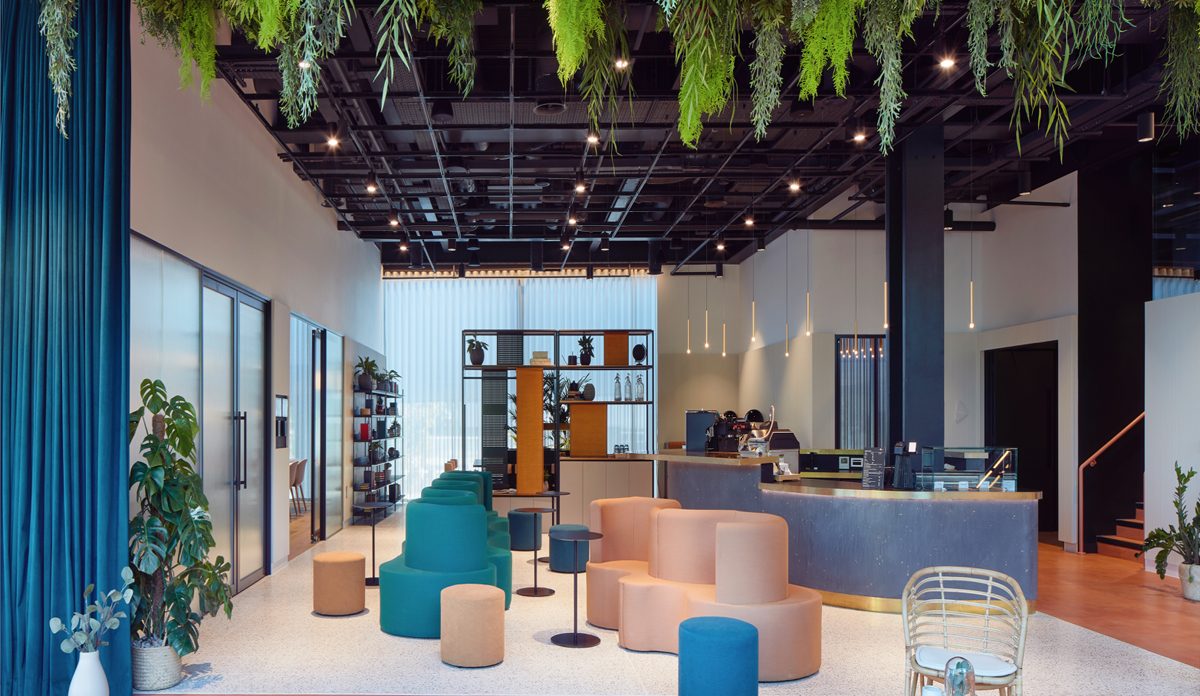
Clay plasters regulate relative interior humidity between 40% and 70%, the level at which the majority of adverse health effects are kept at bay.
Healthy, durable, working buildings can only be brought about by designing with a full understanding of breathability. The current focus on airtightness in design needs also to consider how vapour inside a building will be treated. Clay plasters, made from unfired clays and sands, are considered breathable (with excellent vapour permeability) and hygroscopic.
Unfired clay can absorb and desorb indoor humidity faster than any other building material.
4. ASSOCIATED HEALTH BENEFITS

Reduction in Airborne Bacteria
By keeping relative humidity between 40% and 70% research has shown that the likelihood for airborne infectious bacteria and virus to survive is the lowest. Arundel 1986
Microbe and Mould Control
Water controls the life or the demise of building fabric. The hygroscopic properties of clay plaster minimise wall moulds and areas of damp. A 15mm sample of clay plaster can absorb 5 times the moisture of a sample of gypsum plaster. The ability to absorb humidity varies significantly depending on clay content.
Water controls the life or the demise of building fabric. The hygroscopic properties of clay plaster minimise wall moulds and areas of damp. Experiments at the University of Kassel in Germany proved that a 1-sided 15mm sample of clay plaster could absorb 5x the moisture of a sample of gypsum plaster. The ability to absorb humidity varies significantly depending on clay content.
Through regulating Relative Humidity, the occurrence of mould can be prevented. The graph below shows the relationship between mould occurrence and RH; Ucci, M. 2009, Oreszczyn & Sung-Hugh Hong 2005
While terms like Sick Building Syndrome and Building Related Illness are mentioned in studies more often in the context of mould fungi, other factors of influence are viruses, pollen, mites, nitrogen oxides, carbon monoxide, ozone,. radon, emissions from building and facility materials and electromagnetic fields but also ‘Microbial Volatile Organic Compounds’ (MVOC) and fungus spores.
5. MOULD OCCURANCE & RELATIVE HUMIDITY
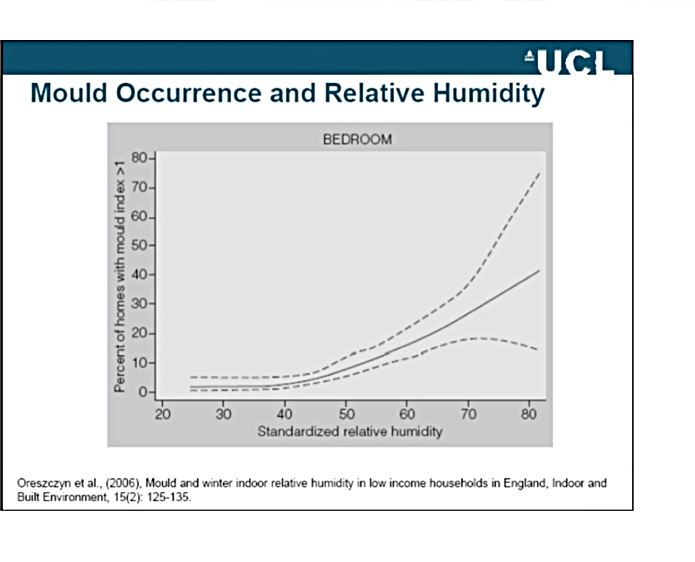
In the study of using unfired clay materials in a test house in Scotland, Tom Morton, Principal Architect at Arc, Fife, UK, states that in the bathroom,
‘The clay plaster had such a strong ability to absorb peaks of air moisture after showers that it cleared the air without surface condensation. The effect of the extractor fan was of no statistical significance’.
6. MOISTURE CONTROL & ASTHMA

Stirling Howieson, in his 2005 book Housing and Asthma highlights that warm, humid conditions in modern buildings are the conditions in which dust mites thrive. Dust Mites are one of the known causes of asthma, and he hypothesises that our homes are the most influential, single, identifiable factor driving the current asthma pandemic in the UK.
Howieson calls on the entire construction sector to improve Indoor Air Quality in our buildings, with particular consideration of moisture control, if we are to address the asthma problem.
Stirling Howieson Housing and Asthma, 2005.
Reduced Formaldehyde
Keeping relative humidity between 40 and 60% also prevents building materials from off-gassing toxins, such as formaldehyde. Arundel 1986
7. WELL
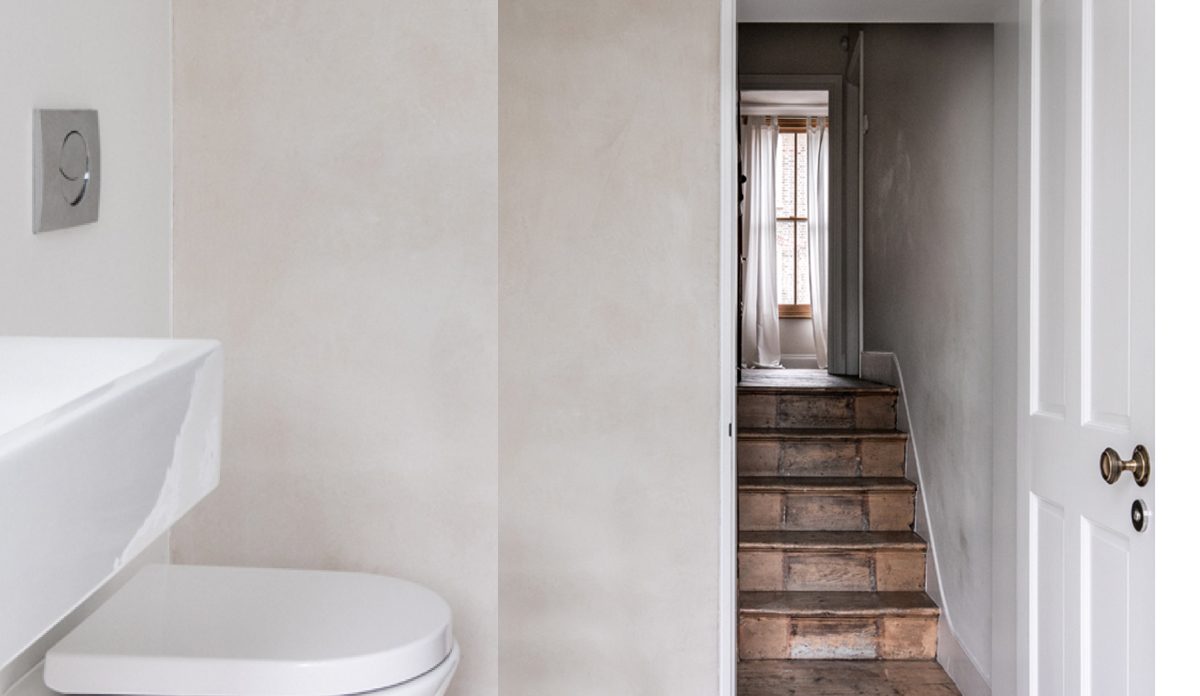
WELL is the leading tool for advancing health and well-being in buildings globally and we have summarised the health benefits of Clayworks Clay Plasters in such a way as to facilitate those who are seeking to achieve this standard.
Launched in the United States in 2014, the WELL Building Standard took all the medical research that had taken place around the world that looked at how buildings impact our health, collated it over seven years and turned it into a building code.
WELL is now the leading tool for advancing health and well-being in buildings globally.
The WELL Standards – Overview and where Clayworks contribute:
- Air
- Materials
- Thermal Comfort
- Sound
- Mind
- Innovation
- Light
(the other WELLbeing standards are Water, Nourishment, Movement, Community)
9. WELL STANDARDS

Air ………………………….. Clay Plasters contribute to Air Quality in multiple ways, principally due to the multiple benefits of breathability.
Material Safety …….. Clayworks Clay Plasters are 100% pure and natural with no toxins. The majority of our Finishes are
pigmented with natural, organic pigments. However, some colours contain chemical pigments – please contact us for further advice. Glazes and Primers may contain synthetics or chemicals.
Thermal Comfort ….. Clay Plasters naturally help to regulate thermal fluctuations.
Sound ……………………. Clay is a flexible material that absorbs and damps sound.
Light ……………………… Natural materials help maintain luminance balance absorbing and minimising glare.
Mind ……………………… Clay makes us feel at home. Relaxed and cocooned.
Innovation ……………. Age-old traditions are evolving with new techniques being developed at our Cornwall home.
10. AIR QUALITY & WELLBEING STANDARDS
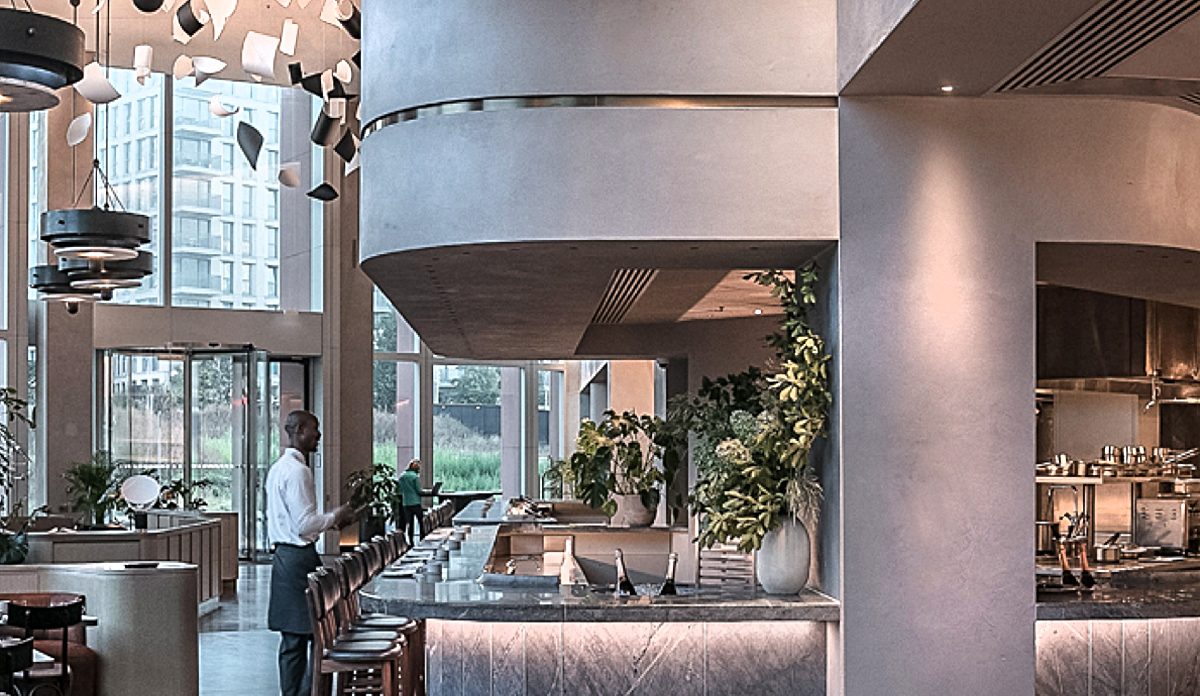
AIR QUALITY
FEATURE A01
Fundamental Air Quality
FEATURE A04
Construction Pollution Management
FEATURE A05
Enhanced Air Quality
FEATURE A13
Active VOC Control
FEATURE A14
Microbe and Mould Control
MATERIALS
FEATURE X01
Fundamental Material Precautions
FEATURE X02
Hazardous Material Abatement
FEATURE X04
Waste Management
FEATURE X10
Volatile Compound Reduction
FEATURE X13
Enhanced Material Precaution
FEATURE X14
Material Transparency
THERMAL PERFORMANCE
FEATURE T01
Thermal Performance
ACOUSTIC PERFORMANCE
FEATURE S04
Sound Absorption
LIGHT
FEATURE L04
Glare Control
NATURE
FEATURE M02
Access to Nature
11. AIR QUALITY STANDARDS

Air Quality is a very important part of the WELLbeing standard, which not only looks at air filtration and ventilation but is focused on keeping the worst of the chemicals and particulate matter and dust out of the buildings, so as not to exacerbate things like allergens or asthma. Clayworks is focused on keeping out of our materials anything that is harmful and ensuring that our Clay Plasters retain optimum breathability.
Breathable
Low VOCs
Synthetic Free
Toxin Free
Off-gassing Free
Low Formaldehyde
12. CLAYWORKS : FUNDAMENTAL MATERIAL SAFETY
No Lead
No Asbestos
No Polychlorinated Byphenyls. (PCBs)
No Mercury
No other Hazardous Materials
Clayworks Clay Plasters also contribute to Toxic Material Reduction targets because they contain no Perfluorinated Compounds (PFCs), Phthalates (Plasticisers), or Isocyanate based polyurethanes.
Hence, they require no special waste disposal. Any waste material may be safely returned to the ground contributing to the Circular Economy.
Electro Magnetic Radiation
Research suggests that clay is anti-static and can screen electromagnetic radiation, although we have no specific evidence or references to support this. We are aware of tests conducted at a University in Munich, Germany in 1999 which showed that solid timber and clay had by far, better radiation shielding properties than concrete, bricks, concrete blocks or stud & plasterboard walls. They concluded that the superior performance of natural materials such as timber and clay is due to their unique cell structures made up of cavities, capillary tubes, cell walls, encased resins and various other materials and that human-made building materials can not compete with nature.
No Flame Retardants
Clay plasters are naturally flame retardant and require no PFCs.
Ozone and Formaldehyde
Research by Corsi and Darlin into the potential of clay plasters as passive removal materials for the removal of ozone in building further accelerates the material’s potential to be truly problem solving on so many levels. Ozone is a respiratory irritant that seeps into our homes and the by-products that are created when ozone reacts with materials such as carpets, cleaning products, materials and furniture are also toxic: they include hydroxyl radicals and other chemicals such as formaldehyde and acetaldehyde.
Dr Richard Corsi and E. Darling, formerly of the Department of Civil, Architectural and Environmental Engineering, The University of Texas at Austin, state that the products of indoor ozone reactions may be irritating or harmful to building occupants. Some by-products created when ozone hits skin oils are probably more toxic than the starting ozone.
Formaldehyde is a Category 1B carcinogen that can also cause skin, eye and respiratory irritation.
The authors are clear that further research is required, but as the understanding of the extraordinary health and sustainability benefits of clay plasters advance and the aesthetic beauty of the material is further innovated, the material clearly has the potential to reframe the interior wall finish sector.
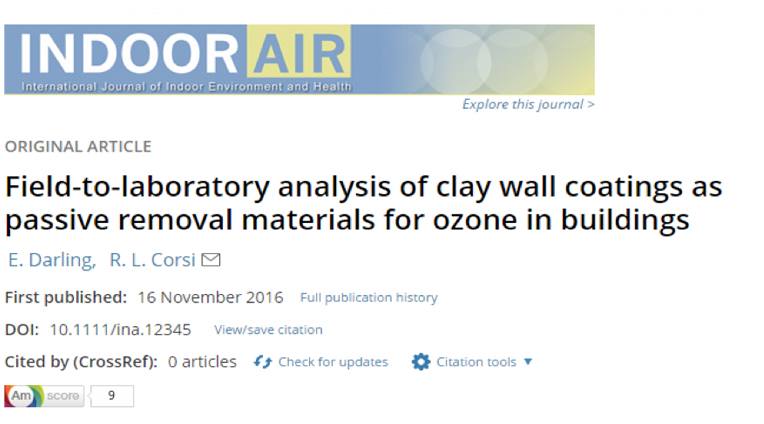
Results indicate that clay-based coatings may be effective as passive removal materials for ozone in buildings … the addition of clay plaster when carpet and ozone were present result in significant improved indoor air quality and lower formaldehyde concentrations.
13. VOLATILE ORGANIC COMPOUNDS

VOCs are a serious risk to health
VOCs comprise one of the most serious risks of all, attracting increasing attention from researchers, including by the journal Science, which has warned of the dangers of exposure to VOCs in enclosed spaces, which, it claims, are up to 10 times higher than outdoors. More info:
VOC emissions specifications in LEED EQ credit “Low -Emitting Materials” for LEED projects globally: The requirements of LEEDv4 and LEED v4.1 BETA (February 2021): CDPH-IAQ (California Department of Public Health (CDPH) Standard Method v1.2 – 2017); abd a TVOC below 0.5 mg/m3 in both office and class room.
VOC content specifications in LEED EQ credit “Low-Emitting Materials” for LEED projects globally:
The requirements of LEED v4 and LEED v4.1 BETA (February 2021): South Coast Air Quality Management District (SCAQMD) Rule 1113 (2016) for Trowel Applied Coatings having a VOC content below 50 g/l.
61% Improvement on Cognitive Function when there are no VOCs
A study led by Harvard University in 2015 concluded that participants in a greener building environment have 61% higher cognitive scores than those in less green buildings. The study involved controlling the presence of VOCs (many of which are harmful to human health) and Carbon Dioxide and doing a series of strategic and response tests. A peer reviewed paper by Harvard University found that on average, workers cognitive scores were 61% higher on so called ‘green building days’: days where low concentrations of VOCs were present. More info:
UK Lagging behind Europe in attention to indoor toxins
‘The UK industry hasn’t really woke up to ‘building chemistry’. There are around 1000 VOCs in circulation in building products, with very little research into the effects of exposure and even less environmental monitoring’: Simon Corbey, ASBP. Via RIBA. More info:
Thermal comfort
Keeping buildings within comfortable thermal parameters and helping to prevent temperature swings is important for not aggravating conditions like asthma, eczema and stress.
Thermal comfort is ranked as one of the highest contributing factors influencing overall human satisfaction in buildings, particularly the workplace.
Clay Plasters, due to the exposed thermal mass and porous hygroscopic properties that help buffer the temperature and relative humidity of the internal environment, will help to mitigate temperature fluctuations within a space and help to promote a more stable temperature.
The thicker the clay plaster finish, the more it will absorb excess heat and cold, helping to maintain more comfortable temperatures.
Sound – Noise Reduction Coefficient (NRC): 0.10 NRC: Sound Absorption Coefficient: 0.090N
Everybody deserves some silence for mental and physical well being, and Clay Plasters help to reduce the transference of noise within a room (scattering). They also help to promote the absorption of sound within a space.
The thicker the clay plaster, the better the performance.
Light – Visual Comfort
Clay plasters do not reflect light, do not glare and in fact, diffuse light ensuring an experience that is soft on the eyes and all of the senses. The natural materials in clay plasters help to maintain luminance balance in spaces by helping to absorb natural and artificial rays.
Mind
‘Air quality is the most important concept’ for mental health in the workplace’.
Ann Marie Aguilar, International Well Building Institute’s director of operations for Europe.
The Institute recognises the importance of materials & is putting pressure on architects to ensure they’re only specifying materials that don’t bring volatile organic compounds, into internal environments.

